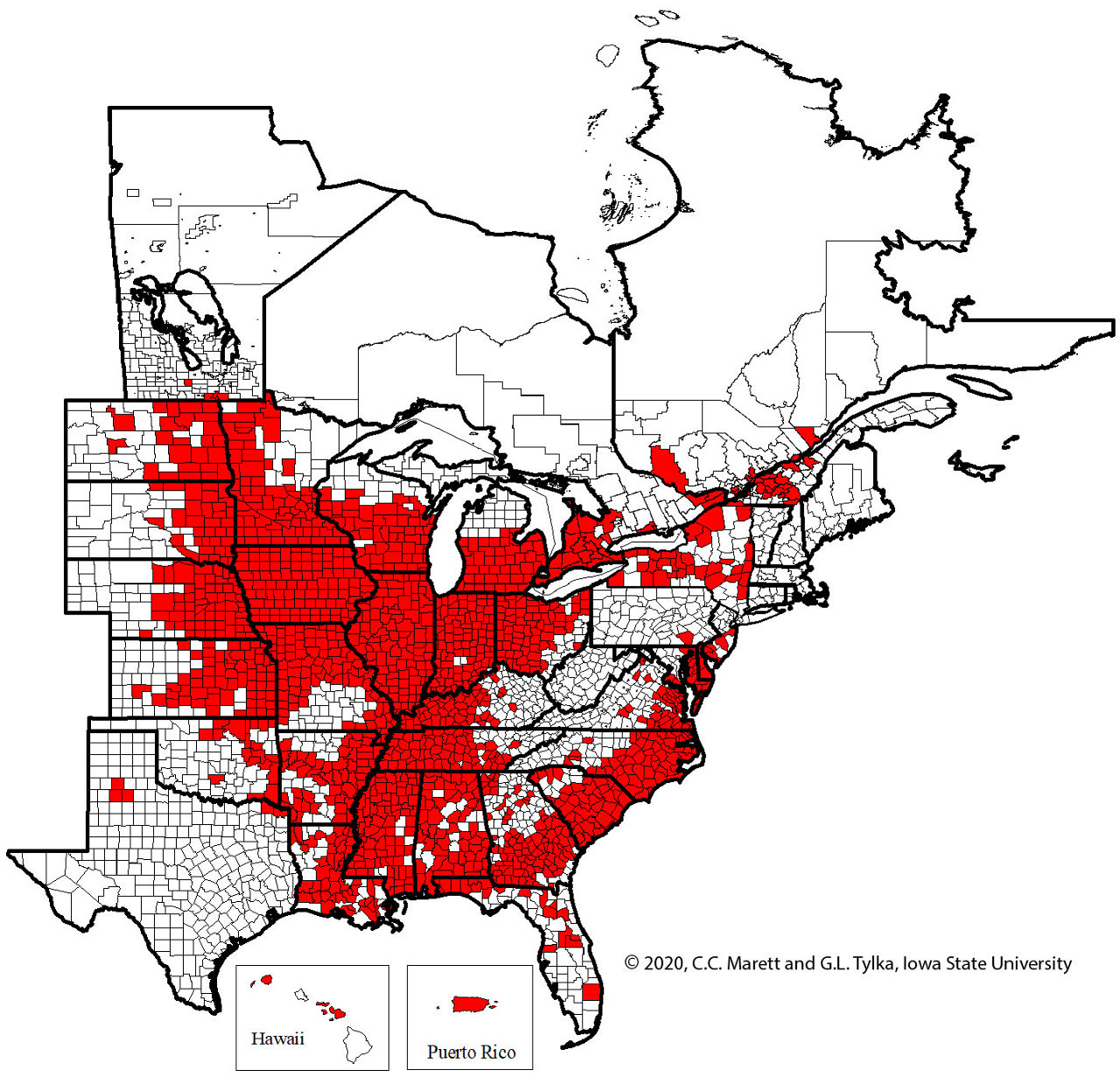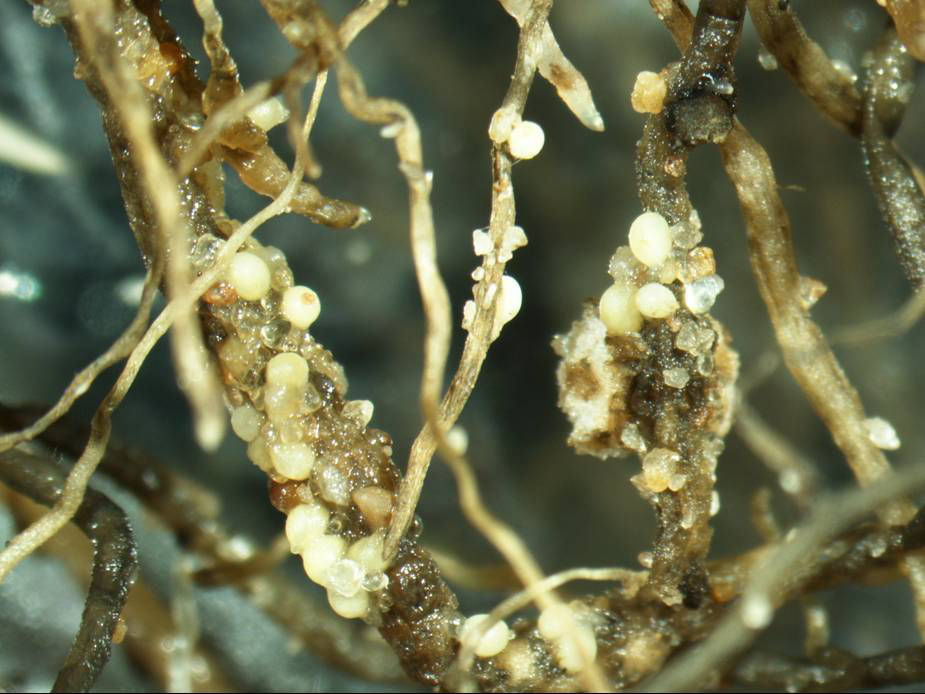8 MIN READ
How and When Do I Sample for Soybean Cyst Nematode (SCN)?
August 1, 2023
Soybean cyst nematode (SCN) management begins with knowing if the nematode is present in a field and determining its infestation level. Yield losses increase as the number of SCN eggs in the soil increases. This information can be determined by sampling soil from each field close to harvest and sending the samples to a nematology laboratory for analysis.1
Soybean Cyst Nematode Concern
Soybean cyst nematode—also known as Heterodera glycines (HG)—is the greatest cause of soybean yield loss throughout soybean production areas worldwide.1 Most soybean producing counties in the United States are infested, and infestations are occurring in Canada (Figure 1).2 Because symptoms of SCN infection can mimic those of other agronomic issues; SCN infestation can go undetected by soybean growers. Injury symptoms often resemble those of nutrient deficiencies, diseases, chemical injuries, compaction, drought, or other stresses. An additional concern is that SCN is showing resilience against the resistant soybean varietal lines that have been used for years to protect yield potential in some areas.1

Description and Identification
Soybean cyst nematodes are plant-parasitic, microscopic roundworms that have three stages of development: egg, juvenile, and adult. After hatching, juvenile Heterodera glycines (HG) roundworms enter soybean roots to feed and to mature into males or females. The adult male roundworms leave the soybean root to mate, while the females become immobile and swell to form a lemon-shaped cyst inside the root. As the females become larger, their bodies (cysts) fill with eggs and eventually break through the root surface while their heads remain embedded within the root (Figure 2). The female cysts are initially white but turn yellow and then brown as they age and finally die. As the cysts mature, some of the eggs may be pushed out of the cyst and released into the soil. Other eggs remain protected within the cyst until it breaks open, which can be several years.

Aside from seeing the cysts on soybean roots, the only way to verify SCN soil presence is through a nematode soil assay, which can also determine the HG roundworm population density. Soil sampling is best done near harvest, as SCN numbers are generally highest at crop maturity.
The first time a field is sampled for SCN, soil should be pulled from areas where SCN is more likely to become established, such as areas which had poor soybean yield in previous seasons, areas along fence lines, near field entrances, in high pH areas, poor weed control areas, and in previously flooded areas. Weedy areas can be important because weeds can be alternate hosts for SCN. Field entrances and flooded areas can be hot spots because equipment and flowing water can be SCN carriers.
Annual sampling is not required after a field is diagnosed with SCN. However, these fields should be sampled every three years, or before an SCN-susceptible soybean product is planted. An HG type test should be considered if SCN-resistant soybean products are experiencing lower-than-expected performance or cysts are observed on the roots of resistant plants. HG type identification replaces the previously used race designation and provides an indication of which SCN-resistance sources would be most effective in a specific field. Soil sampling may differ slightly for HG type testing; therefore, laboratory guidelines should be followed accordingly.
Soybean Cyst Nematode Sampling Recommendations
- Sampling areas should be determined by similarity in soil texture and cropping history, which may require sampling different parts of a field separately.
- Use a cylindrical probe to collect samples to a depth of 6 to 8 inches.
- Pull 10 to 20 soil cores in a zigzag or “W” pattern across the sample area.
- Mix the cores in a container for a representative sample.
- Each soil sample should represent no more than 10 to 20 acres.
Injury to Soybean Plants
Soybean cyst nematode root feeding disrupts nutrient and water uptake by soybean plants, which can hinder plant and root growth. Nodule growth and number can be impacted negatively as well. Heavy infections may result in stunted plants with yellow foliage, especially if plants are also under moisture stress. SCN infection can result in injury to the infected plant, and symptoms can be exacerbated by disease interactions. Ultimately, infected plants suffer reduced pod and seed development.
Visible SCN Injury: SCN presence cannot be easily diagnosed based on foliar symptoms alone, because plant reactions to SCN infection can range from no visible symptoms to plant death. Visual diagnosis is additionally complicated because nutrient deficiencies, herbicide injury, and environmental stresses can mimic SCN symptoms. However, the unique, non-foliar, visible sign of the disease is the white or yellow cysts that appear on the soybean roots. In high yield environments with adequate moisture, foliar symptoms may not develop, though the hidden SCN can still be reducing yield potential by 15% or more in infested fields.3
Disease Interactions: Wound openings on roots from SCN feeding create entry points for other soil-borne pathogens. When present with SCN, diseases such as brown stem rot and sudden death syndrome can increase the negative effects of both infections. It is recommended to address SCN problems before addressing other disease problems, because an SCN infestation is continuous whereas other diseases are mostly environmentally driven.
Soybean Cyst Nematode Management Practices
Once a Heterodera glycines population is established in an area, SCN cannot be eradicated completely. However, proper management can help reduce the HG population. Management practices should include measures that maintain soybean health, reduce SCN infestation levels, and help preserve the yield potential of resistant products.
- Crop rotation provides agronomic benefits regardless of SCN presence. Using a non-SCN host crop, such as corn, cotton, alfalfa, wheat, or sorghum eliminates a food source for SCN, which can help reduce infestation levels.
- Winter annual weeds including henbit, field pennycress, chickweed, shepherd’s purse, and purple deadnettle should be controlled, as they are SCN hosts. If these weeds are growing and soil temperatures are above 50° F, SCN reproduction and infestation levels can increase.
- Practices that help maintain plant health (proper fertility, irrigation, removal of compaction, use of fungicides to help manage foliar diseases, insecticide use if an insect level reaches economic levels, weed control) can help reduce the impact of SCN feeding.
- Some seed treatments offer early season protection against SCN and other nematode species by making young soybean roots unattractive to the nematodes. If SCN pressure is high, the early season protection helps the soybean roots to grow and proliferate fast enough to withstand potential infection later in the season.
- SCN-resistant soybean products help lessen the ability of the roundworm to complete its life cycle, typically by allowing less than 10% of the reproduction that occurs in susceptible products. However, repeated use of SCN-resistant soybean products with the same genetic source of resistance may allow the local HG roundworms to adapt and overcome the soybean product’s SCN resistance. Therefore, SCN-resistant soybean products should be rotated.
Sources:
1Tylka, G. 2019. Managing SCN for 2020 should begin now. ICM News. Integrated Crop Management. Iowa State University Extension and Outreach. Iowa State University. https://crops.extension.iastate.edu/cropnews/2019/11/managing-scn-2020-should-begin-now
2Tylka, G.L. and Marett, C.C. 2021. Known distribution of the soybean cyst nematode, Heterodera glycines, in the United States and Canada in 2020. Plant Health Brief. Plant Health Progress. Volume 22, Issue 1, pages 72-74. The American Phytopathological Society. https://apsjournals.apsnet.org/doi/10.1094/PHP-10-20-0094-BR
3Bond, J., Bird, G., Warner, F., et al. SCN Soybean cyst nematode management guide. 5th Edition. Niblack, T.L. and Tylka, G.L. (Eds.) Plant Health Initiative. North Central Soybean Research Program. https://scn.plantpath.iastate.edu/files/inline-files/SCN_Management_1.pdf
Web sites verified 7/16/23. 1311_142615
Seed Brands & Traits
Crop Protection
Disclaimer
Always read and follow pesticide label directions, insect resistance management requirements (where applicable), and grain marketing and all other stewardship practices.
©2024 Bayer Group. All rights reserved.